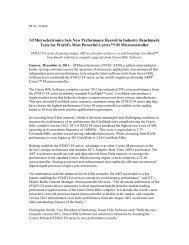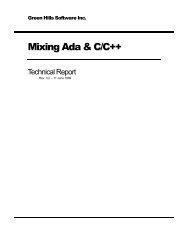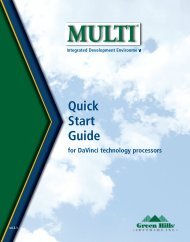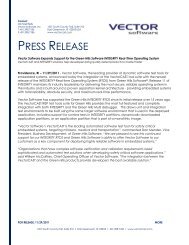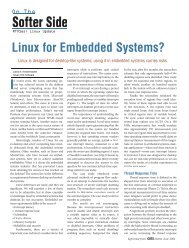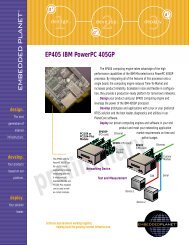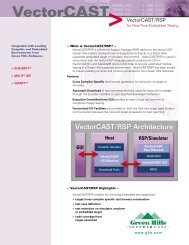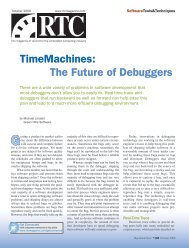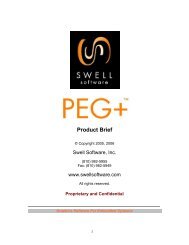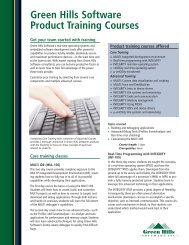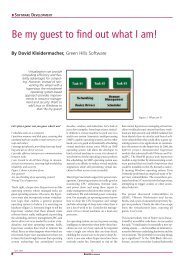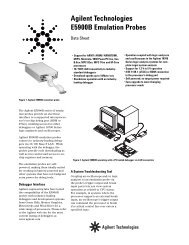PDF document - Green Hills Software
PDF document - Green Hills Software
PDF document - Green Hills Software
You also want an ePaper? Increase the reach of your titles
YUMPU automatically turns print PDFs into web optimized ePapers that Google loves.
Seaweed (4) Soo 14/3/02 4:19 pm Page 1<br />
Technology<br />
Open for business<br />
OpenGL is a viable solution<br />
for avionics application<br />
development as the cost is less,<br />
the route to certification is<br />
more certain and the<br />
timescales are shortened<br />
Martin Beeby and Robert Schulman<br />
Today’s developers of avionics<br />
software face considerable cost<br />
and time-to-market hurdles that<br />
the commercial system developer<br />
might find familiar from 20<br />
years ago. These hurdles include<br />
the time and effort involved in the<br />
design, <strong>document</strong>ation, development<br />
and testing of a custom solution.<br />
Avionics developers have a kind of envy<br />
for the open-standards-based solutions<br />
that are available in other technical arenas,<br />
such as computers, but are unavail-<br />
30 Flight Deck International March 2002<br />
able for the problem at hand. This envy<br />
is particularly noticeable in the avionics<br />
display domain where the benefits of<br />
open-standards-based solutions are<br />
high but are countered by the intensive<br />
certification necessitated by the safety<br />
criticality of aircraft cockpit displays.<br />
A number of companies that produce<br />
avionics displays are tending toward<br />
greater use of OpenGL or an OpenGL<br />
look-alike application programming<br />
interface (API). Display development<br />
tools are now available that generate<br />
OpenGL-calling C code. Such tools<br />
allow system developers to implement<br />
highly complex displays very quickly.<br />
COTS graphics software for avionics<br />
displays can offer great benefits to the<br />
system developer if the COTS software<br />
supplier can meet the certification challenges<br />
required by the FAA.<br />
OpenGL for avionics<br />
As is typical for COTS software users,<br />
the benefits of using COTS software in<br />
avionics applications are important for
Seaweed (4) Soo 14/3/02 4:22 pm Page 2<br />
the systems developer. The benefits<br />
include providing opportunities for<br />
lower risk and providing improvements<br />
in time-to-market. The benefits of<br />
using COTS are potentially even<br />
greater when the software is based on<br />
an open standard, due to such a standard’s<br />
already defined syntax and<br />
semantics, its possibly wide deployment<br />
and its available labor pool.<br />
The OpenGL API, which is a widely<br />
deployed graphics API, is a great example<br />
of where COTS can lead to considerable<br />
benefits for the avionics system<br />
developer. OpenGL is an API standard<br />
that provides 2D and 3D graphics functionality<br />
by taking primitives (points,<br />
lines, polygons, bitmaps and images)<br />
defined by the user and converting – or<br />
rendering – them to an image on a display.<br />
OpenGL is extensively supported<br />
by graphics accelerator hardware that<br />
allows the developer to implement very<br />
complex and powerful display applications<br />
with high refresh rates.<br />
Many avionics display developers are<br />
motivated to use OpenGL in their<br />
applications for the following reasons:<br />
OpenGL is ubiquitous<br />
This gives OpenGL two advantages<br />
over a proprietary API. First, there is<br />
the ubiquity in platforms. Because<br />
OpenGL runs on a variety of platforms<br />
it means that application writers can<br />
develop on a host platform and then<br />
port the application to the target platform<br />
with minimal effort. It is even<br />
possible to use the same graphics accelerator<br />
on the host platform and on the<br />
target platform, making the host that<br />
much closer to the target environment.<br />
Second, there is the ubiquity of the<br />
labor pool. Because OpenGL runs on<br />
many platforms there are a lot of skilled<br />
OpenGL application writers available.<br />
Graphics acceleration<br />
Hardware exists that accelerates<br />
OpenGL and enables high performance.<br />
There is a choice of hardware<br />
that accelerates the entirety of the<br />
OpenGL API. This is important, as any<br />
rendering done without hardware assistance<br />
in a certified environment would<br />
be slow, and because of the complexity<br />
of the software rendering stack, troublesome<br />
for the FAA to certify for use.<br />
OpenGL is leveraged<br />
There are a number of tools that help<br />
the designer of graphic avionics applications<br />
generate the displays, or ‘formats’,<br />
that are displayed. The tools typically<br />
run on workstation platforms and<br />
the engineer tweaks the format until it<br />
looks right and responds appropriately<br />
to inputs. Once the engineer is happy, a<br />
button is pressed and C code is emitted<br />
that implements the format. The emitted<br />
code has to call some sort of graphics<br />
library, and more often than not that<br />
library is either OpenGL or something<br />
very similar.<br />
Even though OpenGL is very well<br />
suited to embedded avionics display<br />
applications it was never designed with<br />
safety or high availability in mind. For<br />
OpenGL to really fulfill its potential in<br />
the avionics display domain there are<br />
certification issues that need to be<br />
addressed.<br />
Certification to RTCA/DO-178B<br />
FAA certification is required for any<br />
software used on or connected to an<br />
aircraft, and it must adhere to guidelines<br />
known as RTCA/DO-178B -<br />
usually referred to simply as DO-178B.<br />
The FAA characterizes software as<br />
belonging to one of five levels of criticality,<br />
‘A’ through ‘E’. Level A is the<br />
Technology<br />
Table 1: Definition of DO-178B software criticality level<br />
Level Definition<br />
Level A <strong>Software</strong> whose anomalous behavior, as shown by the system safety assessment<br />
process, would cause or contribute to a failure of system function resulting in a<br />
catastrophic failure condition for the aircraft.<br />
Level B <strong>Software</strong> whose anomalous behavior, as shown by the system safety assessment<br />
process, would cause or contribute to a failure of system function resulting in a<br />
hazardous/severe-major failure condition for the aircraft.<br />
Level C <strong>Software</strong> whose anomalous behavior, as shown by the system safety assessment<br />
process, would cause or contribute to a failure of system function resulting in a major<br />
failure condition for the aircraft.<br />
Level D <strong>Software</strong> whose anomalous behavior, as shown by the system safety assessment<br />
process, would cause or contribute to a failure of system function resulting in a minor<br />
failure condition for the aircraft.<br />
Level E <strong>Software</strong> whose anomalous behavior, as shown by the system safety assessment<br />
process, would cause or contribute to a failure of system function with no effect on<br />
aircraft operational capability or pilot workload. There are no certification requirements<br />
for this level of software.<br />
Table 2: DO-178B verification requirements versus software level<br />
Objective <strong>Software</strong> level<br />
A B C D<br />
Test procedures are correct ● ▲ ▲ ■<br />
Test results are correct and discrepancies explained ● ▲ ▲ ■<br />
Test coverage of high level requirements is achieved ● ▲ ▲ ▲<br />
Test coverage of low-level requirements is achieved ● ▲ ▲ ■<br />
Test coverage of software structure (modified<br />
condition/decision coverage) is achieved ● ■ ■ ■<br />
Test coverage of software structure (decision<br />
coverage) is achieved ● ● ■ ■<br />
Test coverage of software structure (statement<br />
coverage) is achieved ● ● ▲ ■<br />
Test coverage of software structure (data coupling<br />
and control coupling) is achieved ● ● ▲ ■<br />
Legend ● = The objective should be satisfied with independence<br />
▲ = The objective should be satisfied<br />
■ = Satisfaction of the objective is at the applicant's discretion<br />
Independence requires the activity to be performed by someone independent from the developer<br />
most critical and applies to systems<br />
which, if they fail, would probably lead<br />
to a catastrophic failure of the aircraft.<br />
Level E is at the other end of the spectrum<br />
and refers to systems which, if<br />
they fail, will probably go unnoticed<br />
(Table 1). Aircraft displays that provide<br />
critical parameters to the pilot, such as<br />
altitude, attitude and speed are required<br />
to be certified to Level A. As the criticality<br />
of the software is increased, so is<br />
the rigor in the development and verification<br />
requirements in DO-178B<br />
(Table 2).<br />
The DO-178B guidelines do not<br />
mandate processes or <strong>document</strong>ation<br />
formats, but provide objectives, activities<br />
and evidence that must be satisfied<br />
by the software developer. Fundamentally<br />
the FAA needs to know that the<br />
software implementation is characterizable<br />
and bounded in the time domain<br />
(how long things take to do), in the<br />
space domain (how much memory<br />
things use) and does what it is required<br />
to do. In other words, under all<br />
Flight Deck International March 2002 31
Seaweed (4) Soo 14/3/02 4:23 pm Page 3<br />
Technology<br />
OpenGL overview<br />
The OpenGL graphics system is a highperformance,<br />
window system independent,<br />
software interface to graphics hardware. It<br />
provides a very rich API to the applications<br />
developer for generating high-quality color<br />
2D and 3D graphics efficiently. It is typically<br />
used in conjunction with graphics acceleration<br />
hardware to provide performance suitable<br />
to real-time applications.<br />
OpenGL was developed by Silicon<br />
Graphics Inc. (SGI) based on a decade of<br />
experience in computer graphics hardware<br />
and software design. Control for the<br />
OpenGL standard has been turned over to<br />
the OpenGL Architecture Review Board<br />
(ARB), which consists of leaders in the computer<br />
industry. Its founding members<br />
included DEC, IBM, Intel, Microsoft and<br />
Silicon Graphics. The collective vision underlying<br />
OpenGL is that through a common, fast<br />
software interface for programming graphics,<br />
3D graphics can rapidly become a mainstream<br />
computer technology. You do not<br />
need to look very far to see evidence that<br />
OpenGL has realized this goal.<br />
The authors of the OpenGL API prefer its<br />
users to think of the API as providing a state<br />
machine (see figure opposite) that happens<br />
to render 3D graphics. The state machine<br />
can further be thought of as providing the<br />
following features: vertex, pixel and primitive<br />
operations (the primitives being points, lines<br />
and polygons), display lists, texturing, lighting,<br />
modeling, projection and viewport transforms,<br />
perspective, clipping, a variety of<br />
color models and display lists, and Z, accumulation,<br />
scissor and alpha buffers. These<br />
features are offered in an orthogonal manner;<br />
that is, the use or non-use of a feature<br />
does not depend upon the use or non-use of<br />
another feature. This orthogonality has the<br />
advantage that users combine features in<br />
ways undreamed of by the designers of<br />
OpenGL – which means that OpenGL is<br />
used in unanticipated problem domains. This<br />
orthogonality has the further advantage that<br />
it makes subsetting the API achievable and<br />
meaningful (by ‘meaningful’ we mean that<br />
the retained portions of the API retain all the<br />
semantics held in the unsubsetted API).<br />
The authors of the OpenGL API also<br />
wanted the API to be portable among a variety<br />
of environments. To this end they deliberately<br />
kept any mention of ‘window system’<br />
out of the OpenGL API. By avoiding reference<br />
to, or a dependence on, the window<br />
system within the API, they skirted neatly<br />
around portability issues with respect to window<br />
systems. This is one of the reasons why<br />
the OpenGL API can exist in Windows, the X<br />
Window System, MacOS, BeOS and OS/2.<br />
As well as a studied refusal to refer to the<br />
host window system, OpenGL also segregates<br />
a few system-dependent functions<br />
regarding buffer swap and management of<br />
the data ‘bundle’ that carries the state of the<br />
OpenGL state machine. The same structuring<br />
that allows for environment portability at<br />
the workstation-class also allows for environment<br />
portability for embedded, ‘non-standard’<br />
systems.<br />
32 Flight Deck International March 2002<br />
required conditions the behavior of the<br />
software can be characterized.<br />
OpenGL was never designed with<br />
safety of implementation in mind.<br />
Indeed, commercially available<br />
OpenGL implementations, of some<br />
200,000 lines of code and 300 API<br />
functions, are probably uncertifiable to<br />
high levels of DO-178B without considerable<br />
modifications.<br />
To overcome the drawbacks of existing<br />
implementations it would be necessary<br />
to develop from scratch a certifiable<br />
OpenGL implementation. Typically<br />
software developed to meet DO-178B<br />
takes around one person month to<br />
develop 125 lines of code with all the<br />
supporting processes and <strong>document</strong>ation.<br />
So an implementation of 200,000<br />
lines of code would take about 1,600<br />
person months, or 133 person years.<br />
To provide a useful rendering layer,<br />
while still fulfilling the rigor of DO-<br />
178B, the preferred route is to subset<br />
the OpenGL API and only include the<br />
portions that the application needs.<br />
Avionics applications that want to use<br />
OpenGL as their rendering layer typically<br />
have two display needs:<br />
● Simple 2D graphics showing such<br />
things as various forms of dials and<br />
gauges in digital form;<br />
● More complex 3D graphics for outthe-cockpit<br />
terrain painting views. Such<br />
uses include drawing a kind of highwayin-the-sky<br />
and aiding in collision avoidance<br />
either between aircraft or between<br />
aircraft and the ground.<br />
Small 2D and 3D subsets of the<br />
OpenGL API can address the majority<br />
of avionics display needs. By subsetting<br />
the API the implementation effort is<br />
lighter, the set of requirements is<br />
smaller, the amount of testing is lessened,<br />
and the <strong>document</strong>ation evidence<br />
that shows everything was done according<br />
to DO-178B guidelines is more<br />
manageable. The subsetting work does<br />
not only benefit those who are creating<br />
a certifiable OpenGL implementation.<br />
It also benefits the customer because<br />
the cost is less (due to less work), the<br />
route to certification is more certain<br />
(due to lower complexity), and the time<br />
scales are shortened (due to less coding<br />
and testing).<br />
The amount of effort put into an<br />
OpenGL implementation for the highest<br />
safety level consists of about five<br />
percent driver development and 95 percent<br />
DO-178B activities and evidence<br />
generation. It is not that the driver<br />
development is not important – it most<br />
certainly is because avionics customers<br />
absolutely require performance. But<br />
what is even more paramount than performance<br />
is correctness. The most<br />
favorable path to correctness is comprehensive<br />
planning, combined with<br />
complete and demonstrable analysis,<br />
and a perfectly <strong>document</strong>ed and<br />
By minimizing the software required to drive the<br />
display, we minimize the time, effort and risk of<br />
certifying the software<br />
ultimately flawless execution of the driver<br />
development.<br />
To further minimize the software<br />
effort, the hardware element of the<br />
solution has to have complete coverage<br />
of all OpenGL rendering functionality.<br />
This requirement is not onerous as<br />
graphics hardware available for use in<br />
the avionics market, for example the<br />
Permedia 3 and Glint graphics accelerator<br />
product lines from 3Dlabs, do<br />
implement the complete OpenGL<br />
engine in hardware. Such complete<br />
hardware rendering assistance means<br />
that rather than requiring complex software<br />
to effect rendering, complex hardware<br />
can be substituted combined with<br />
much simpler software to drive that<br />
hardware. By minimizing the software<br />
required to drive the display, we minimize<br />
the time, effort and risk of certifying<br />
the software.<br />
COTS meets the DO-178B<br />
challenge<br />
Seaweed Systems has developed from<br />
scratch implementations of 2D and 3D<br />
subsets of the OpenGL API. These<br />
implementations have been targeted to<br />
meet the highest certification requirements<br />
for avionics display systems by:<br />
● Designing the implementation to be<br />
static in its memory use;<br />
● Minimizing the dependence on operating<br />
system facilities, to allow deterministic<br />
behavior and portability across<br />
embedded operating systems;<br />
● Enforcing coding standards that lead<br />
to simple, deterministic and verifiable<br />
code;<br />
● Using requirements-based testing
Seaweed (4) Soo 14/3/02 4:24 pm Page 4<br />
to verify implementation to the<br />
ensure no dead code exists within the<br />
implementation;<br />
● Addressing the DO-178B objectives<br />
from the beginning of the software<br />
development;<br />
● Carrying out the DO-178B activities<br />
and producing the evidence required<br />
during development.<br />
Once the software product has been<br />
developed it is necessary to package the<br />
software and all the required certification<br />
evidence and data for customers.<br />
The FAA only gives certification to<br />
complete systems, examining the use<br />
of each software component with<br />
respect to a system and how the software<br />
component has been validated as<br />
part of the system. Even though the<br />
software component may have previously<br />
been included in systems that<br />
have been certified, it does not necessarily<br />
follow that the software component<br />
will be certified in the new system.<br />
The use of the software component<br />
within the system is a key element of<br />
the overall system safety.<br />
For example a system that uses a<br />
multi-tasking operating system, that has<br />
previously been included in successful<br />
certification submissions, does not help<br />
if the application has the potential for<br />
deadlock between tasks. While this<br />
example is an over simplification, it<br />
serves to illustrate that use of a software<br />
component is more important than<br />
prior certification history. For this reason<br />
it is not possible for COTS vendors<br />
to get standalone certification for any<br />
software components that they supply.<br />
Even though it is not possible to certify<br />
a COTS software component in isolation,<br />
it is possible to package that component<br />
in a form that facilitates certification<br />
by systems developer.<br />
What Seaweed Systems has done<br />
with OpenGL is not unique. There is<br />
other COTS software that is certifiable,<br />
which either supports an OpenGL<br />
renderer or requires the presence of<br />
such a renderer. A well-designed piece<br />
of COTS software results in the greatest<br />
benefits to systems developers<br />
when a suite of COTS products is<br />
used in combination. Products like<br />
eNGENUITY Technologies’ Qualifiable<br />
Code Generator (QCG) can be<br />
used to auto-generate certifiable,<br />
embedded code for display applications.<br />
QCG requires a rendering layer, like<br />
Seaweed Systems’ Certifiable OpenGL<br />
implementation.<br />
OpenGL implementations rely on,<br />
Some hardware vendors<br />
who are not dedicated<br />
to the avionics market<br />
are very protective of<br />
their technology and<br />
will not divulge certain<br />
information<br />
and applications can benefit greatly<br />
from, facilities provided by embedded<br />
operating systems such <strong>Green</strong> <strong>Hills</strong>’<br />
INTEGRITY OS and WindRiver’s<br />
VxWorks OS, both of which are<br />
certifiable. Hardware vendors such as<br />
Radstone and Dy4 are able to support<br />
the hardware requirements for avionics<br />
systems and use graphics devices from<br />
3Dlabs.<br />
For hardware, particularly for graphics<br />
accelerator devices, the hardware<br />
vendor also needs to be ready, willing<br />
and able to assist the customer through<br />
the entire life-cycle of the product and<br />
provide information critical to the<br />
application developer’s certification<br />
Technology<br />
Pixel data Vertex data<br />
Pixel<br />
operations<br />
Texture<br />
assembly<br />
Display list<br />
Rasterization<br />
Per-fragment<br />
operations<br />
Frame<br />
buffer<br />
Evaluations<br />
Per-vertex<br />
operations<br />
and primitive<br />
assembly<br />
Simplified OpenGL state machine, showing order of operations to produce an image in the frame buffer<br />
submission. Some hardware vendors<br />
who are not dedicated to the avionics<br />
market are very protective of their technology<br />
and will not divulge certain<br />
information about their architecture or<br />
processes. Some require use of technologies<br />
that are uncertifiable. These<br />
vendors do not provide viable solutions<br />
for systems developers.<br />
It is only with products from vendors<br />
such as those mentioned above,<br />
who truly understand and support the<br />
certification requirements for avionics<br />
systems, that the system developer can<br />
make best use of COTS solutions. A<br />
clear set of COTS hardware and software<br />
products is emerging that truly<br />
support avionics developers.<br />
❖ Robert Schulman is president of Seaweed Systems<br />
and has held a variety of engineering and management<br />
positions at companies in the database, OS,<br />
and graphics field both in the USA and in Japan.<br />
He founded Seaweed in 1993. Martin Beeby is<br />
director of software development for the company<br />
and has held various software development and<br />
management positions in the UK and USA for<br />
companies developing avionics, safety critical and<br />
mission critical software. Beeby joined Seaweed<br />
Systems in 2001<br />
Flight Deck International March 2002 33



